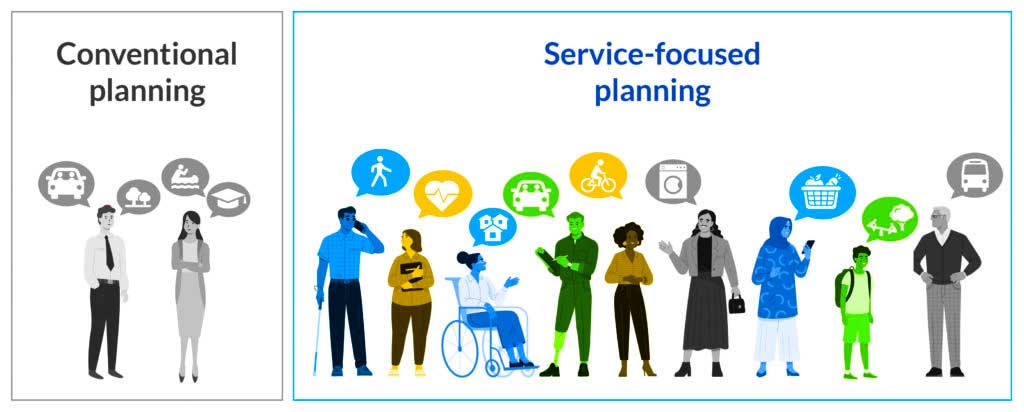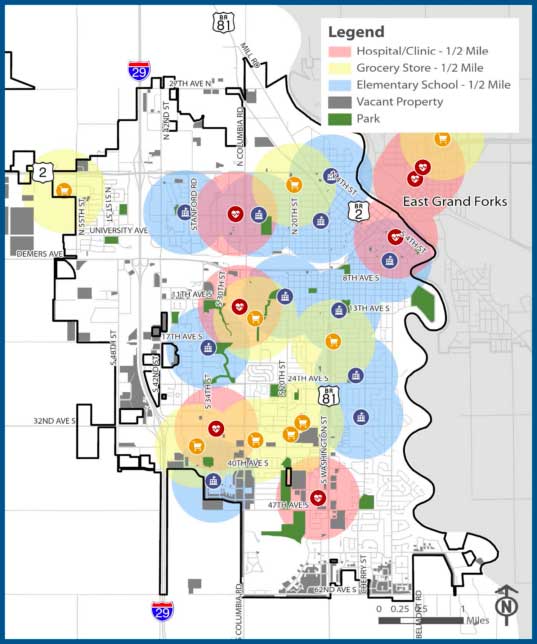Are you ever frustrated that the community planning process relies on all-too-familiar data sets and analysis and only simple snapshots of public input? Community planning can and should include a deeper, more organic approach that is responsive to people’s essential needs, such as access to fresh food, medical needs, and recreational spaces. To capture a more comprehensive picture of people’s essential needs, it takes a different approach to data analysis and a more dynamic and expansive approach to gaining public input.
Service-focused community planning is planning with a comprehensive spectrum of critical community services and amenities in mind.
Conventional community planning strategy focuses on finding the appropriate balance of a community’s land uses and ensuring adequate transportation connections. Public uses are part of the equation in balancing land uses—for example, understanding the need for and appropriate locations for schools, fire stations, or parks. Service-focused community planning builds on this conventional approach with a more comprehensive spectrum of critical amenities and services in mind. It takes into account the needs of a fuller, broader spectrum of the community and the needs and services they rely on.

Service-focused planning fosters an equitable approach, addressing the following perspectives that may be overlooked in the traditional process:
It starts with engagement
Service-focused planning requires engaging with and paying attention to the needs of a broader cross section of the community than is typically gained through traditional means of in-person and online engagement. This especially means those who traditionally do not participate in the planning process, such as the underserved, busy families, or those with a language barrier. In this way, a greater understanding is developed of services and amenities that are important to those who are often missing from the process and, as a result, the foundation is laid to create a more equitable plan that is more responsive to their needs. Beyond this, relationships are fostered between community members and its leaders. Oftentimes, a planning project can be the first time a group’s voice is even recognized by the local government.
Broader public health perspective
In addition to emergency services, hospitals, and other traditional medical services, other important health considerations may include access to fresh food (e.g., community gardens and grocery stores), multimodal facilities to promote active transportation, or connections to social services and programs and resources for underserved populations. For these populations, multimodal connections are likely to be more important than vehicular connections.

evaluate infill development opportunities and develop supportive policy.
Greater focus on infill opportunities
The repurposing of vacant land and underutilized space can make dramatic positive financial and social impacts on communities. Investment in the redevelopment of space for retail services, housing, and livable outdoor space saves time and money by utilizing existing utilities and creating new tax revenue. Infill areas will be easier to access for many underserved populations. By concentrating development in underutilized areas, it can activate these areas and stimulate the local economy, even local neighborhoods.
Prioritization of sustainability
Service-focused community planning incorporates sustainable and active transportation options, which not only promotes better health, but also reduces vehicle emissions and increases access to local businesses. This framework emphasizes the importance of connecting neighborhoods, institutional areas, retail and service areas, and major employment areas so that residents can easily access jobs, services, amenities, and cultural attractions without relying on cars for transportation. The concept of complete streets can be taken a step further when thought of as complete connections between neighborhoods and service areas.
We have an ethical obligation as planners to make life easier for people with a focus on finding ways to connect people to essential services and related needs, all with a goal to reduce socioeconomic segregation. This requires more than a conventional community planning approach. The key is that this approach is never as simple as one-size-fits-all—the role of broad, meaningful engagement is critical to defining the shape of each community’s plan to be most responsive to its own unique populations. Only after thoughtful, comprehensive engagement, will data analysis and planning tools, such as GIS, make the greatest impact on the planning process.

Throughout his 17 years of planning experience in the public and private sectors, Scott Harmstead, MPA, AICP, has always focused on the people of the communities he serves – enhancing their quality of life, ensuring equitable access to amenities, and empowering them to succeed. His work has included the development of comprehensive and other long-range plans, including constraints analysis, public involvement, and the development of context-sensitive recommendations and policy language. Many of Scott’s projects have involved a strong transportation component, through which he has gained a sound understanding of the connection between land use and transportation in shaping communities.
Scott was recently presented with the 2023 Planner of the Year award by The Western Planner for being highly regarded by his peers and other industry professionals for his honorable service to communities in the western US.

